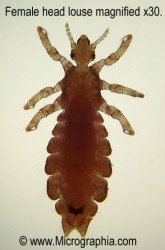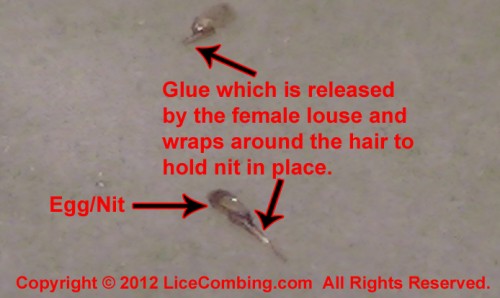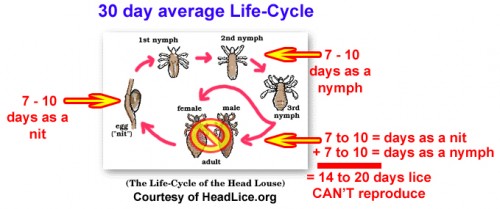The Science
This page is based on published science and practical experience gaine d while in the lice removal business. As with any science, contradictory reports exist. We do not report all findings, but attempt to represent a current picture of head lice based on relevant studies as it pertains to our hands-on experience. This website is subject to revision as new information is discovered or published. As always, please discuss all information first with your health care professional before attempting at home.
d while in the lice removal business. As with any science, contradictory reports exist. We do not report all findings, but attempt to represent a current picture of head lice based on relevant studies as it pertains to our hands-on experience. This website is subject to revision as new information is discovered or published. As always, please discuss all information first with your health care professional before attempting at home.
MEDICAL TERMS:
- Pediculus Humanus Capitas = Head louse (louse is singular).
- Pediculosis = Head lice infestation.
SLANG:
- Cooties (also slang for body lice).

DESCRIPTION:
- 6 legged arthropods, 3 legs on each side of the body towards the front.
- Each leg has a “claw” at the end making them adept at holding onto hair for survival.
- Head lice are parasites. They spend their entire life on one host, in this case a human.
- They are wingless and can’t fly.
- They have no hind legs and they can’t hop or jump like grasshoppers.
NITS:
- Common usage has lumped nits and eggs as interchangeable terms.
- Nits are “super-glued” onto a single hair by a female louse as she lays the egg while sitting on the scalp. This is why newly laid nits are found closest to the scalp.
- Nature has probably made this “super glue” water proof.
- Although the mother’s glue surrounds the hair shaft, nits are found in a casing on ONE SIDE of the hair strand. This sets them apart from other debris that may be found in the hair.
- Nits need the warmth of the scalp to “incubate.”
- As the hair grows, empty nit casings (already hatched lice) or nonviable nits (dead nits) will move farther away from scalp if not removed.
- Nature makes it so the nit will not dislodge easily from a hair strand. Briefly touching a nit will not move it from its position (i.e. dandruff moves when touched).

- Newly laid eggs will hatch in an average of 7 – 10 days (just in time before hair growth moves it further away from the scalp heat needed to incubate).
- Nit casings are empty shells left after a louse has hatched.
- Not all eggs laid will be viable, but it’s difficult to differentiate. All nits and lice should be removed.
- Nit glue may keep a nit casing in the hair until the hair naturally falls out or nit casing is pulled out manually.
- Nits CAN’T withstand the pressure of being pulled out either by hand or a comb, a natural and safe way to take them out.
- Removing ALL lice and nits breaks the life-cycle of lice.
NYMPHS:
- Nymphs are the term for newly hatched lice that have not reached maturity or the adult stage.
- The nymph stage lasts an average of 7 – 10 days after hatching.
- Lice nymphs go through 3 molts (casting off of outer exoskeleton layer as they grow).
- It is important to remember that nymphs are unable to reproduce at this stage and thus removing them with a lice comb breaks the life-cycle.
LIFE-CYCLE:
- Lice have an average 30 day life cycle.
- Nits take an average of 7 – 10 days to hatch after being laid.
- Newly hatched lice (called nymphs) molt (shed their outer skin to continue to grow) 3 times before becoming an adult. This molting takes an average of 7 – 10 days.

- 7-10 days as a Nit + 7-10 days as a Nymph = 14 – 20 days in which lice CAN’T reproduce.
ORIGINS:
- Some researchers believe head lice have been around for 5.6 million years.
- Anthropologists found head lice body parts in the braided hair of a 1,000 year old mummy.
Internet search: Molecular Identification of Lice - Head lice do not come from dirt or animals. Lice have been around a long time and are here to stay.
TYPES OF HUMAN LICE:
- 3 general types: Head, Body, Pubic
- Head Lice live primarily on the head with some exceptions of them finding their way to eyebrows and eyelashes in heavy infestations.
- Body lice can live on clothes and come off to feed (human blood) as needed.
- Pubic lice, i.e. crabs, live in the pubic region.
- Some researchers believe these 3 types rarely intermingle, but current studies report head lice may have emerged from body lice.
- Due to the fact that body lice (NOT HEAD LICE) need dirty conditions to thrive (unwashed clothes and bodies), it is a misconception that head lice need the same dirty conditions. They do not.
- Head Lice can live in both dirty OR clean hair. Head Lice are equal opportunists.
SIGNS OF LICE:
- Most common sign is itching, but not all itching means lice.
- Itching because of head lice is cause by the saliva released by the louse when they suck blood from a scalp. A louse’s saliva may cause a person to produce histamine, a chemical your body produces when you are allergic to something. Please note that not all individuals will itch possibly due to a lower lice count on the head or they are not susceptible.
- Lice poop. Tiny, grain-like and pinpoint black dots of feces may be spotted on the head, around the ears, and on pillows. These are easily missed due to size or being washed out.
- Raised or reddened bumps on the head and nap of neck caused by a person scratching.
- Secondary infections due to bacteria from the hand/fingernails entering broken skin during a scratch.
- An individual may report restless sleep thought to be caused by unconscious frequent head scratching.
The only true way to know someone doesn’t have lice is to regularly lice comb.
FOOD SUPPLY:
- Human blood every few hours.
- Head lice suck, they do not bite.
OPTIMAL TEMPERATURE:
- Any human scalp with hair is a warm place for a louse.
- Warm scalp temperatures may be anywhere from 71° – 86°, perfect for lice (98.6° is considered the normal internal body temperature).
- The human body regulates itself to keep temperatures constant both internally and externally. Example: Even if your head is directly in the sun, a person perspires to cool down the skin surface to keep it an even temperature.
SIZE:
- Size depends on the age of a louse or nit.
- Adults are an average of 3mm. They have been likened to the size of a sesame seed.
- Nits/Eggs can 1 mm or smaller when newly laid. In comparison, grains of sand have been measured at .02 – 2 mm.

COLOR:
- Head lice color depends on age. Usually newly hatched lice are nearly transparent before they take a blood meal.
- The more meals the louse ingests, the darker the louse becomes.
- Larger and darker lice are usually older.
- Note: Although internet “reports” of lice taking on the color of a host’s hair have been stated, we have not experienced this nor located any scientific studies citing this change. In our practice, color was dependent on age of the louse.
LOCATION:
- Although lice can be anywhere in the hair, they generally are found close to the scalp where it’s warm and they have access to a blood meal.
- The female louse sits on the scalp (or very nearby) when laying nits, thus newly laid nits are on hairs closest to the scalp.
- Nits can and have been found anywhere on the head. Some researchers report the hair at the nape of the neck and behind the ears as favorite locations. We have found them all over the head.
- Lice can crawl easily from one side of the head to the other. One study reported they can crawl 9 inches in a minute.
VECTORS FOR DISEASE:
- Infections can occur with bacteria from fingers/hands transferring to broken skin during an itch.
- Microorganisms that have the potential to cause disease have reportedly been found in head lice in Ethiopia. We are unable to find any current studies looking at this issue in the U.S.
Internet search: Bartonella quintana in Ethiopian lice or HeadLice.org for current reports.
TRANSMISSION:
- Primary transmission : Direct head to head contact
- Secondary transmission: Via personal belongings (towel, comb, brush, hat, scrunchie, ponytail holder etc.)
- Note: Although not unheard of, our experience leads us to believe that secondary transmission is low. We interpret this to mean that more time and energy should be spent lice combing an individual rather than worrying about inanimate object transmission or hours spent cleaning the home. Vacuuming/clothes dryer/lint brush roller cleaning should STILL take place after a live infestation is found, but regular lice combing is still key in breaking the life-cycle of lice.
